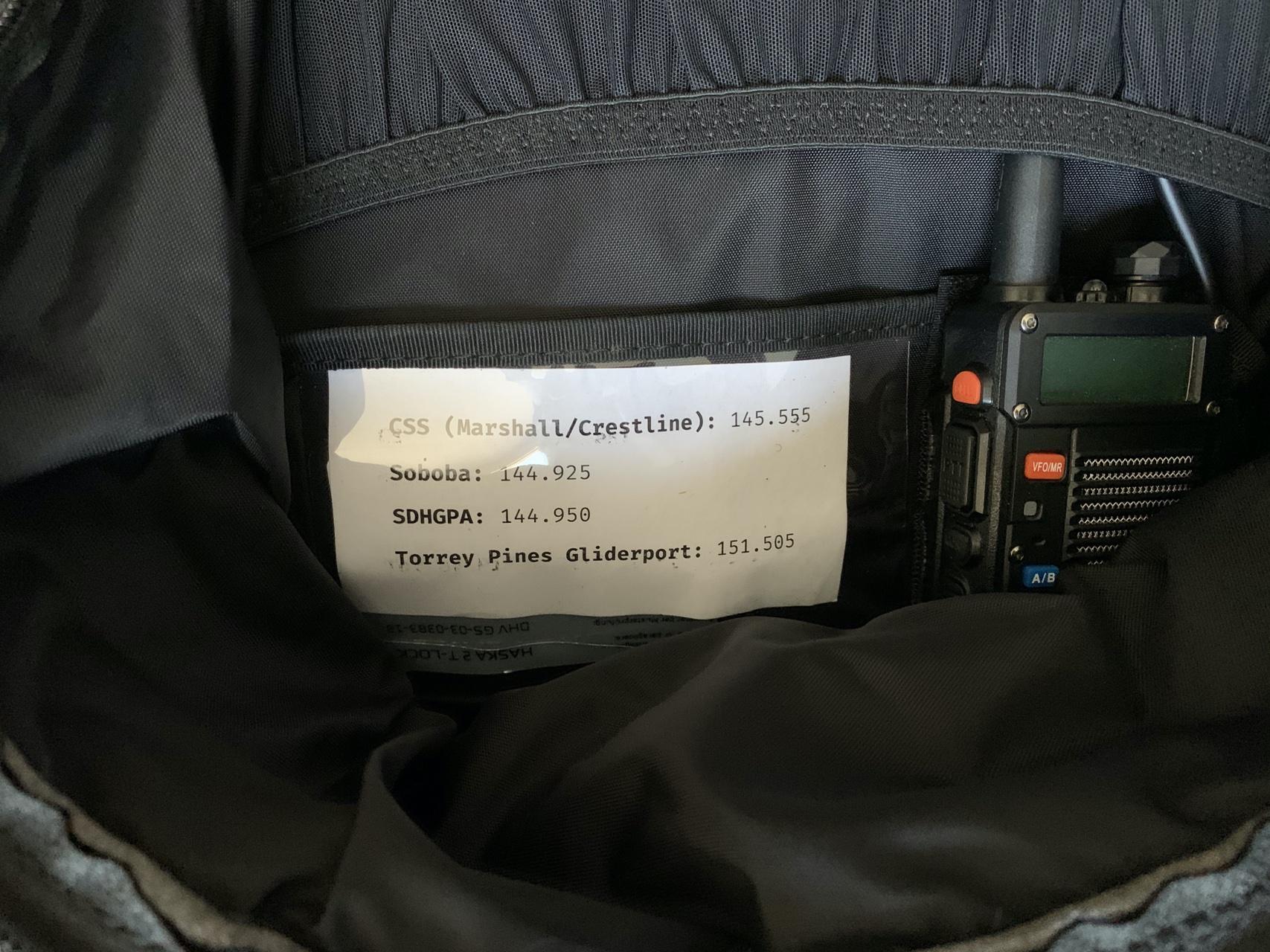Tagged: frequencies, radio, safety
- This topic has 9 replies, 7 voices, and was last updated 4 years, 10 months ago by
 George Stebbins.
George Stebbins.
-
AuthorPosts
-
June 9, 2020 at 12:16 PM #9020
 David Webb General Member
David Webb General MemberPer Albert’s suggestion, adding the “local” frequencies commonly used in the hopes that it encourages more radio use. I’m sure there are others (chime in if I missed any), but these are the ones I hear being used the most:
- CSS Club / AJX: 145.555
- Soboba (some instructors use this one): 144.925
- SDHGPA (San Diego): 145.525
- SHGA (Sylmar): 147.580
- Torrey Pines Gliderport: 151.505
- Elsinore: 144.120
Don’t know how everyone’s radios are mounted, but if it helps anyone, mine is mounted upside-down in the back pocket of my harness (using a speaker mic mounted on the shoulder strap). I keep a printed list of those frequencies right next to my radio so it’s easy to punch them in (I don’t have the programming cable for my radio so I can’t add labeled memory slots – this works just as well):
 June 12, 2020 at 11:33 PM #9057
June 12, 2020 at 11:33 PM #9057If flying Lake Elsinore (HG/PG) most common 2 meter frequency is 144.120 but don’t expect a lot of the locals to be using radios. If using GA aircraft radios, the skydive center and sailplane tow operations and landings are on 122.9. Some sailplanes may be on 123.5 once clear of the airport and drop zone. Hemet based sailplanes usually are on 123.3 when clear of the airport. Hemet airport traffic is on 123.0
Easy way to remember Elsinore 2 meter frequency is: 12×12 = 144. And then add 12 again for the decimal yielding 144.120
June 13, 2020 at 8:51 PM #9076 David Webb General Member
David Webb General MemberThanks Alan – added Elsinore to the list above.
June 17, 2020 at 1:41 PM #9167FYI, the CSS frequency is the only one of those that is actually a simplex frequency in the Southern California band plan (Torrey is a business band USHPA frequency).
You are likely to have interference from and interfere with repeater operation on the 144.9xx frequencies and you may interfere with operators on 144.120 without ever knowing it, since it is designated for AM, SSB & other weak signal/narrow bandwidth modes.
Adherence it the band plan is not legally required, but is respectful of other amateur radio operators. A license is required to use any of these frequencies.
http://www.tasma.org/TASMA-2m-Band-Plan.pdf
Reavis – K0RSG
August 8, 2020 at 11:16 AM #9924FYI,
The New San Diego/ SDHGPA simplex freq is: 145.525
August 8, 2020 at 8:23 PM #9927 David Webb General Member
David Webb General MemberThanks Steve! I’ll add it to the list.
August 15, 2020 at 7:55 AM #9975 Stan Barankiewicz General Member
Stan Barankiewicz General MemberSo, Reavis, what freq. do you suggest we switch to?
August 20, 2020 at 6:49 AM #10030We’re good Stan. CSS’s 145.555 conforms to the band plan. The club’s former frequency was a repeater frequency that was in use way out by San Fernando Valley. When the repeater moved to chino or corona, our site was within range of the repeater’s output, so all we heard was ham radio blab at high output. The club needed a new freq and selected a simplex channel from the band plan.
I thought it would be cool to get with the TASMA people to designate a narrow width to free flight, but that mission is yet unaccomplished and looking for a commanding officer to forward it.
September 12, 2020 at 9:54 AM #10215Jeff Brown from SDHGPA has reached out to TASMA to get frequencies designated for free flight.
The topic is up for discussion at their next meeting but has been delayed due to COVID-19.
September 12, 2020 at 2:06 PM #10216According to SHGA’s web site, their frequency is 147.580. This does not, as far as I can tell, conform to the band plan. We/they used to use 147.555, which also didn’t conform. They switched when a repeater got in their way, I think. I have been flying Marshall for a while due to covid (long story*), so I’m not sure if what their web site says is what they are actually using.
*Short(ish) version of long story: I’m unwilling to ride up with others, or hike. I ride my eBike up after flying. Marshall takes much less time and effort to ride up than Kagel. (Although, the Towers launch at Kagel might be even easier. It does however become unsafe in my opinion if there’s any West component at all to the wind, and it was overgrown until a recent cleaning by the SHGA. Yay!) In any case, I’ve been flying both sites for years, so no reason not to spend more time at one than the other when needed. :-)
-
AuthorPosts
- You must be logged in to reply to this topic.